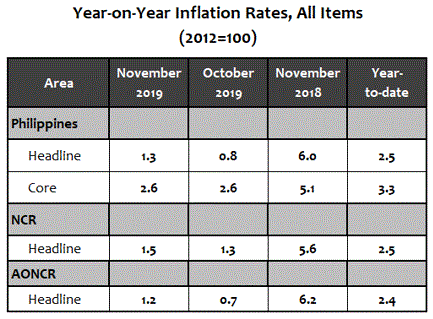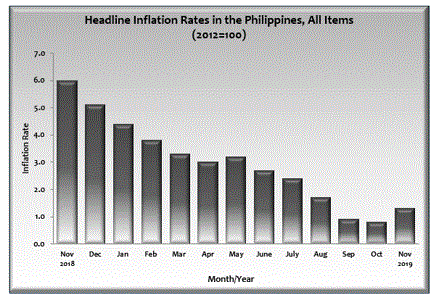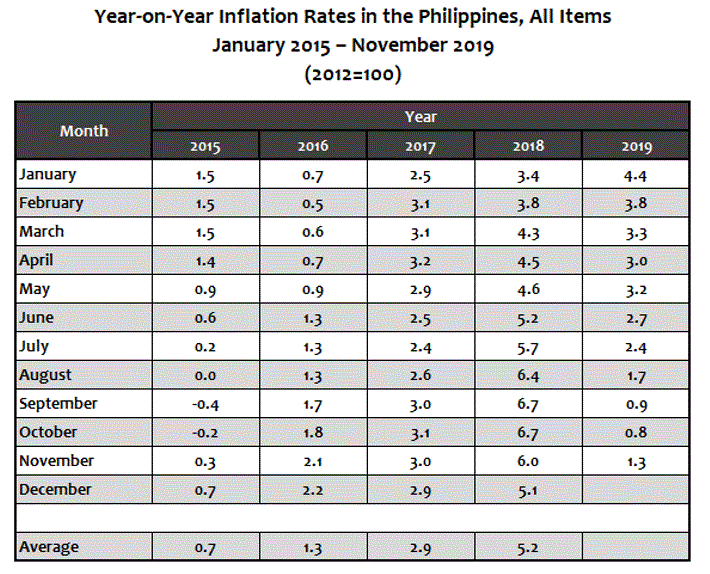YEAR-ON-YEAR
Philippines
The year-on-year headline inflation at the national level accelerated to 1.3 percent in November 2019, after it decelerated for five consecutive months since June 2019.
Inflation in October 2019 was recorded at 0.8 percent and in November 2018, 6.0 percent.
Higher annual increases registered in the indices of the following commodity groups resulted to the uptrend of inflation in November 2019:
- Alcoholic beverages and tobacco, 17.6%;
- Housing, water, electricity, gas, and other fuels, 1.2%;
- Furnishing, household equipment and routine maintenance of the house, 2.8%;
- Health, 3.1%; and
- Communication, 0.3%.
Slower annual gains were, however, observed in the indices of clothing and footw ear at 2.6 percent; and restaurant and miscellaneous goods and services, 2.7 percent. The annual rate of the transport index went down further by 2.4 percent during the month.
ear at 2.6 percent; and restaurant and miscellaneous goods and services, 2.7 percent. The annual rate of the transport index went down further by 2.4 percent during the month.
The index of the heavily-weighted food and non-alcoholic beverages registered an annual growth of zero percent in November 2019, from 0.9 percent annual drop in October 2019. The rest of the commodity groups retained their previous month’s annual rates (see Tables 3 and 4).
Excluding selected food and energy items, core inflation remained at its previous month’s annual rate of 2.6 percent. It was higher by 5.1 percent in November 2018 (see Table 9).
The food index at the country level posted an annual decline of 0.2 percent in November 2019. Inflation for food in October 2019 was recorded at -1.3 percent, while in November 2018, it went up by 7.7 percent (see Table 7).
Annual decreases were still noted in the indices of rice at 8.3 percent; corn, 2.2 percent; and sugar, jam, honey, chocolate and confectionery, 3.8 percent. Moreover, slowdowns were observed in the annual increments of the following food groups during the month:
- Other cereals, flour, cereal preparation, bread, pasta and other bakery products, 2.7%;
- Oils and fats, 0.6%;
- Fruits, 8.4%; and
- Food products, not elsewhere classified, 5.6%.
The rest of the food groups exhibited higher annual mark-ups during the month (see Table 5).

National Capital Region (NCR)
Inflation in NCR picked up further by 1.5 percent in November 2019. In October 2019, inflation in the area was recorded at 1.3 percent and in November 2018, 5.6 percent. Annual increases were higher in the indices of food and non-alcoholic beverages at 2.2 percent; and alcoholic beverages and tobacco, 11.8 percent. In addition, the annual rate of housing, water, electricity, gas, and other fuels rose by 0.7 percent from -0.2 percent in the previous month.
On the contrary, the indices of the following commodity groups registered slower annual gains in November 2019 relative to their annual rates in October 2019:
- Clothing and footwear; and furnishing, household equipment and routine maintenance of the house, both at 1.1%;
- Health, 1.7%;
- Communication, 0.1%; and
- Restaurant and miscellaneous goods and services, 2.6%.
Moreover, the annual change of transport index declined further by 4.4 percent. Other commodity groups retained their previous month’s annual rates (see Tables 3 and 4).
Areas Outside NCR (AONCR)
Inflation in AONCR, likewise, went up by 1.2 percent in November 2019. In the previous month, inflation in the area was observed at 0.7 percent and in November 2018, 6.2 percent.
Compared with their annual rates in the previous month, annual increments were higher in the indices of the following commodity groups:
- Alcoholic beverages and tobacco, 18.7%;
- Housing, water, electricity, gas, and other fuels, 1.4%;
- Furnishing, household equipment and routine maintenance of the house, 3.4%;
- Health, 3.3%; and
- Communication, 0.3%.
Meanwhile, slower annual mark-ups were seen in the indices of education at 4.2 percent; and restaurant and miscellaneous goods and services, 2.8 percent. For three consecutive months now, negative annual rates were still noticed in the indices of food and non-alcoholic beverages at -0.5 percent, and transport, -1.8 percent.
The other commodity groups retained their previous month’s annual rates (see Tables 3 and 4).
Six regions in areas outside NCR had higher positive annual rates during the month. The highest inflation among the regions in areas outside NCR was still noted in Region III (Central Luzon) at 2.2 percent, while the lowest remained in Region IX (Zamboanga Peninsula) at -0.5 percent (see Table 4).
Note: CPIs and inflation rates by province and selected cities are posted at the PSA website (http://openstat.psa.gov.ph/).
(Sgd) CLAIRE DENNIS S. MAPA, Ph.D.
Undersecretary
National Statistician and Civil Registrar General
See more at the CPI and Inflation Rate page.
